Catalogue > Search
Results for : Tout le catalogue

Ulu Braun
Gerhard-Trailer
Video | hdv | color | 2:0 | Germany | 2024
An ecstatic biopic about the world's most successful living painter. In vivid images, this AI hybrid film sheds light on the social role of painting in the field of tension between creativity, capital investment and spirituality. We are currently in the middle of the transition phase from analog to artificial reproducibility. Gerhard's unique painting techniques, especially squeegeeing, have triggered a worldwide hype. His techniques and ideas are being adapted, refined and improved by global “protagonists” and then flooded the markets (+social media). The myth of the “genius” writes itself into the DNA of an increasingly uncontrollable chain of creation as a fabulous and controversial homage.
Ulu Braun (1976) lives in Berlin and Finland. Between 1996 - 2005 he studied painting and film in Vienna, Helsinki, and Berlin. He has been using the medium of video to explore the field between the visual arts and auteur cinema since 1997 and he is one of the key figures who have transferred painting into video art. His works are regularly shown at film festivals and exhibited in art institutions.
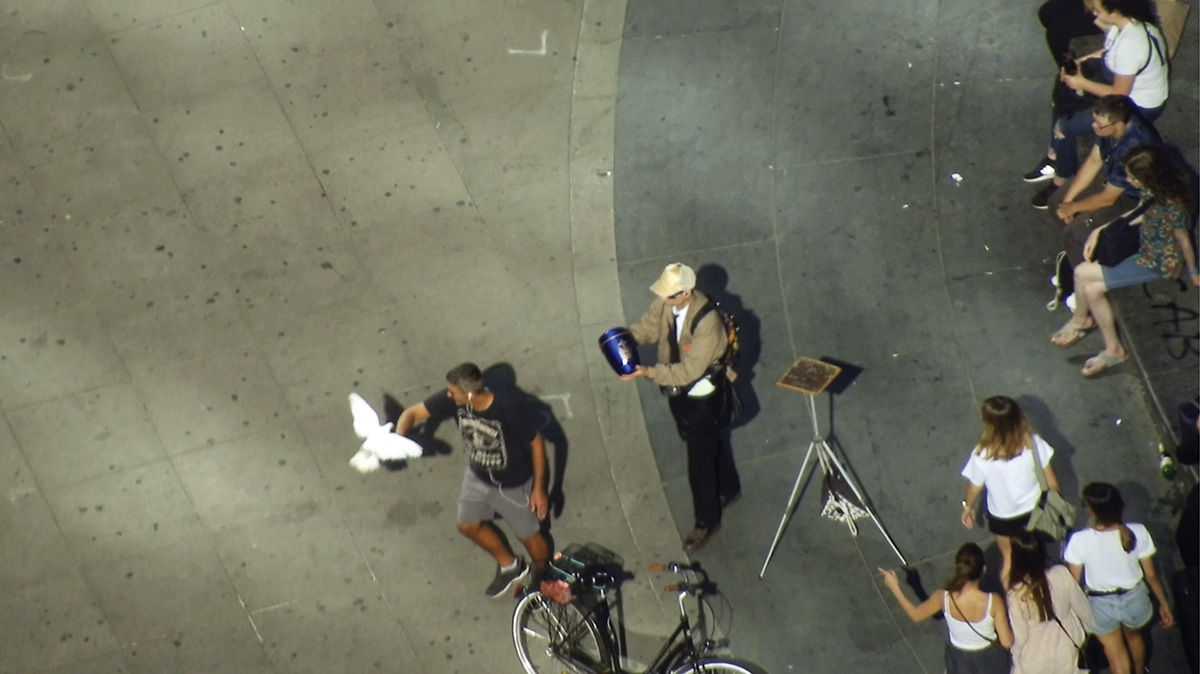

Ulu Braun
SATURNE
Experimental film | mov | color | 74:0 | Germany | 2022
The magical-realist camera follows the trials and encounters of Jonathan as he attempts to fulfill his mother’s final wish: that her ashes be laid to rest at Alexanderplatz, Berlin. Carrying her blue urn and searching for a suitable location, he attempts to gain permission, assistance, and sometimes merely empathy from his fellow citizens. From bridges to construction sites, electronics megastores to public fountains, encountering a nun, an artist, and various figures he traces circles around the concrete epicenter of the busy metropolis, revealing a place where commerce, branding, bustle, and tourism overshadow historical landmarks and personal relations. The private pathos of a son mourning his mother encounters the cold and normalized absurdity of hypercapitalism, history, and everyday city life.
Ulu Braun (1976) lives in Berlin and Lieksa. Between 1996 - 2005 he studied painting and film in Vienna, Helsinki, and Berlin. He has been using the medium of video to explore the field between the visual arts and auteur cinema since 1997 and he is one of the key figures who have transferred painting into video art. His works are regularly shown at film festivals and exhibited in art institutions.
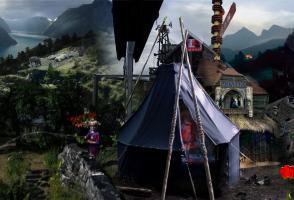

Ulu Braun
Südwest
Art vidéo | | color | 1:45 | Germany | 2006
Südwest is a detailed and utopic construction of a landscape, which unites aspects of tradition and globalisation. The video combines idyllic scenes from the European culture with the catalogue- promises of modern tourist industry to form a panorama which thus recreates the poetic mystique of things so common to our eyes.
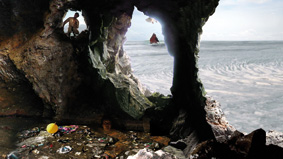
Ulu Braun
WESTCOAST
Video | | color | 7:20 | Germany | 2009
Westcoast is a panorama-video consisting of interweaved scenes mounted on a coastline - somewhere between Rotterdam and Sydney. Starting from a bubbling primordial soup the view pans along a waterfront in the style of a late transnational financial eclecticism and passes mystical spots such as a giant hippo eating carrots and hectically spinning rubber boats. After a dark spiritual waterway recalling Hieronymus Bosch atmospheres, the panorama ends in a cave with refuse-Jacuzzi in which a white woman gazes about herself melancholically.
Ulu Braun (1976) is belonging to a new generation of artists that entered the field of digital film with a background in visual arts and street art. In his works he integrates various production methods to form sceneries that play between Hollywood, Prado and periphery. In most of his works he observes the tragic of reality from different angles. Braun exhibits internationally including recent solo shows in Germany, Belgium, USA and group shows in Germany, Spain, France, Finland, Estonia and Greece. His works have been screened at the major experimental Film and Media Art Festivals. Collaborations with Roland Seidel as BitteBitteJaJa and finnish artist group YKON. He is currently living in Berlin. www.ulubraun.com

Adriana Bravo, Ivanna Terrazas
Beso de chola (Chola Kiss)
Video | hdv | color | 4:0 | Bolivia | 2016
Sophie Roger is already known for her art of detour, which she practices to take us through unexpected paths with friendship as a common thread, an art displayed in Le Point Aveugle (FID 2012) and Les Jardiniers du Petit Paris (FID 2010). Here too, delicately woven onto the screen, this is about friendship, with a Sudanese refugee in Le Havre named Mohamed. This friendship rests on sharing, attention, listening and laughs, waves upon waves, the very waves from the eponymous text by Virginia Woolf which she reads out to him, or the waves painted by Courbet in a painting at Musée du Havre, which he lightens up with his gaze. (FIDMarseille)
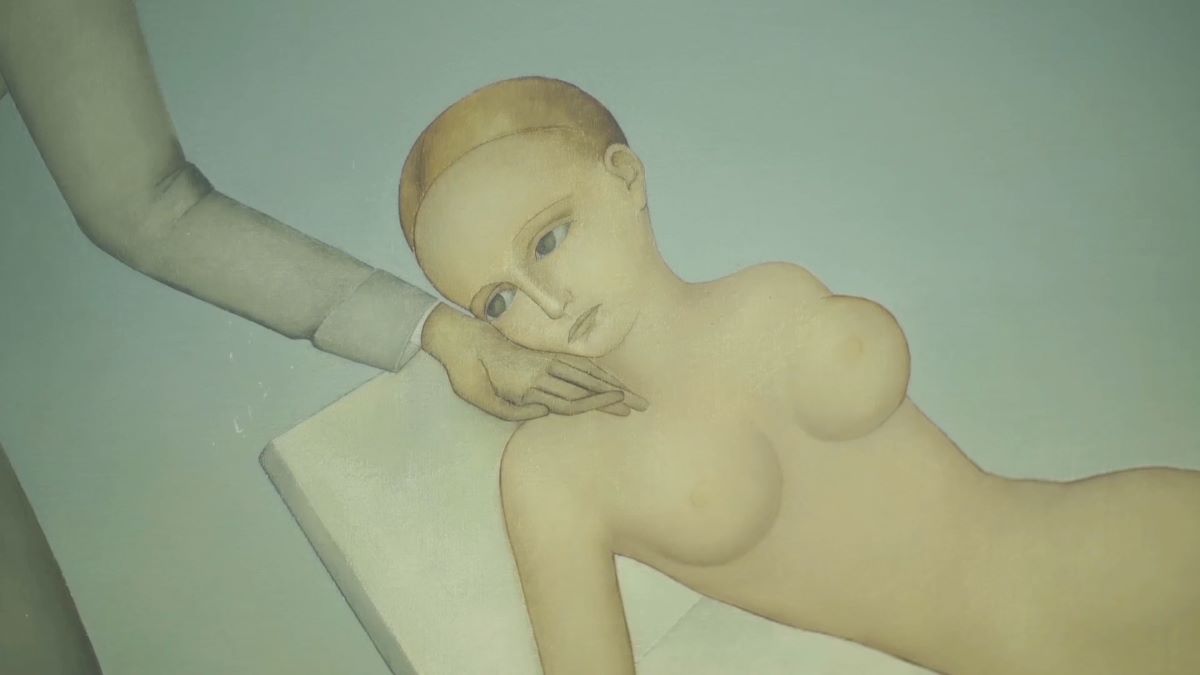

Pamela Breda
The Shape of Things to Come
Experimental fiction | hdv | color | 25:0 | Italy, France | 2022
What is the future of life in a world ever more dominated by Artificial Intelligence Can we develop a sense of connection and empathy towards highly elaborated machines? In a time when the lines between humanity and technology blur, "The Shape of Things to Come" takes audiences on a journey of human-AI interaction that challenges our perceptions of identity, love, and ethics. The film follows the activities of a team of pioneering researchers pushing the boundaries of AI technology, seeking to develop an AI with the capacity to feel and understand emotions. As they delve deeper into the mysteries of human emotions, they confront ethical dilemmas, technical challenges, and unforeseen consequences. Tensions rise as the project advances. Some believe that bestowing AI with emotions could revolutionize healthcare, therapy, and human-AI partnerships, while others fear the potential risks and moral implications. " The Shape of Things to Come " explores profound questions about the nature of consciousness, the essence of humanity, and the ethical responsibilities that come with playing the role of creator. As the project's success seems within reach, the researchers must confront their own humanity and the consequences of their ambition.
Pamela Breda is an artist, filmmaker and researcher living between Turin and Vienna. She holds a MA in Visual Arts from IUAV University (IT) and a PhD in Visual Arts from Kingston University (UK). She was appointed artist and fellow in residence at several international art institutions, including Max Planck Institute For Empirical Aesthetics (Frankfurt, DE), Pratt Institute (New York, USA), Cité Internationale Des Arts (Paris, F), PROGR (Bern, CH) Botin Foundation (Santander, E). She was recipient of several art awards and fellowships, including IMèRA Fellowship (Marseille, F), Cantica 21 (MibaC, IT), Italian Council Award (MibaC, IT), Kingston University Phd Scholarship (Kingston, UK), Moving’Up (Turin, IT), JRC, Joint Research Center, European Commission (Ispra, IT), ‘Love Me Tender’, Stonefly Production Prize (Fabbrica del Vapore, Milano, IT), Italian Institute of Culture (Moscow, RU), Photography Award, IED, European Institute of Design (Venice, IT). Her film research explores the intersections of visual imaginaries, narratives, and stories that often remain on the fringes of mainstream consciousness. With a deep passion for shedding light on the voices and experiences of marginalized communities, her work dives into the complex web of human existence, particularly focusing on the clash between old and new technologies that shape worldviews.

Pamela Breda
April
Experimental video | dcp | color | 13:21 | Italy | 2020
“April” is a short experimental film inspired by the life of April Ashley, one of the first British to un¬dergo sex reassignment surgery on 12 May 1960, performed in Casablanca, Morocco, by doctor Georges Burou. After returning to Britain, Ashley began using the name April Ashley and became a successful fashion model, appearing in such publications as Vogue (photographed by David Bailey and winning a small role in the film “The Road to Hong Kong” directed by Norman Panama. After a friend sold her story to the media, in 1961 under the headline “’Her’ secret is out”, the Sunday People outed Ashley as a trans woman. She became a centre of attention and some scandal, and her film credit was instantly dropped. The scandal forced to live abroad for several years. She was given legal status as a woman only in 2006.
Pamela Breda is an artist and filmmaker living between London and New York. She was recipient of several art awards and fellowships, including the Sirovich Family Fellowship (Pratt Institute, USA), Simultan Art Prize (PL), Cantica21 (IT), Italian Council Award (IT), Mo¬ving’Up Prize (IT), Italian Institute of Culture (RU). Her films have been screened internationally and presented at festivals and art venues such as “ECRA Film Festival” (Rio de Janeiro, Brazil), “Revolutions Per Minute Festival” (Boston, USA), “Digital Film Library”, Clermont- Fer¬rand Film Festival (Clermont-Ferrand, F), Cite Internatinale Des Arts, (Paris, F), “Vision Du Reel” Film Festival, Media Li¬brary (Nyon, CH), “Hazel Eye Film Festival” (Tennesse, USA), “The Bomb Art Factory Film Festival” (London, UK), Sohonya Art Center (Bangalore, I), Francesco Fabbri Foundation for Contemporary Art (Pieve di Soligo, IT), Bevilacqua La Masa Foundation (Venice, IT).

Karolina Bregula
Dust
Experimental fiction | mov | color | 21:45 | Poland, Taiwan | 2021
Dust is a story about two women living in an old district earmarked for demolition. Since their building is due to be demolished soon, all the neighbours have already left. Yet, the women decide to stay in their flat. The protagonists spend time in the abandoned multi-storey building and observe through the window bulldozers working around. Four out of five films were made in collaboration with Ms. Zou and Ms. Huang from Daguan in Taipei. When the project was in production, their houses in Daguan were bound for demolition while Ms. Zou, Ms. Huang together with their neighbours kept fighting against the evictions in the district. The first two films are a fictive story staged with Ms. Zou and Ms. Huang in an empty building awaiting demolition in central Taipei. I entered the building, cleaned up and furnished one chosen flat to turn it into a friendly liveable space and used it as a film location. Another two films are a conversation between Ms. Zou and Ms. Huang, Ms. Huang singing a sad song which reminds her of home and an image of a Daguan streets. The last film is a documentation of the demolition of the house where the first two films were made. One month after the films were done, Ms. Zou and Ms. Huang were forced to move away and Daguan was demolished.
Karolina Bregu?a (b. 1979) is a visual artist, a graduate of the National Film School in ?ód?. She creates films, photographs, installations and performance. Her work explores the problems of the status of the artwork and the materiality of art objects. She critically scrutinises contemporary art and its reception. She creates stories about art and architecture, which are a field of her anthropological and sociological observations. She is interested in the connection between art and reality – the favourable and detrimental effect of artists’ work, the remedial and destructive force of artistic activity, rituals connected to art and art’s social role. Many of her works are co-created with their protagonists and participants, blurring the border lines between professional and amateur artistic activity. Her works have been exhibited at institutions such as National Museum in Warsaw, Jewish Museum in New York and MOCA Taipei and at international events such as Venice Art Biennale and Singapore Biennale. She is the winner of the second prize in the Views 2013 Deutsche Bank Foundation Award, the third Samsung Art Master 2007 award and the 2016 Golden Claw at the Gdynia Film Festival. Her works are included in collections such as Tokyo Photographic Art Museum, Zach?ta National Gallery of Art, Wroclaw Contemporary Museum and ING Polish Art Foundation. She is an associate professor at Academy of Art in Szczecin, she collaborates with lokal_30 Gallery. She lives in Warsaw.

Karolina Bregula
Wieza
Experimental fiction | hdv | color | 78:0 | Poland | 2016
`The Tower` is an opera musical about a group of people who live in the same concrete block of flats and who plan building a sugar tower together. Full of absurd and anxiety, the story of the utopian project is addressing the history of post war housing architecture analysing it from the position of its user, the inhabitant of a modernist city. The dreams and desires are juxtapositioned with difficult reality of life in the blocks and contradictions inscribed in the modernists` plans.
Karolina Bregula(born 1979) is a visual artist and filmmaker. She has performed and exhibited in places such as “the VeniceArt Biennale” the Jewish Museum in New York and the National Museum in Warsaw.She has received numerous awards including The Golden Claw at Gdynia Film Festival, the Views 2013 and Videobrasil 2015. She has been awarded multiple scholarships including the Polish Ministry of Culture Scholarship, the Visegrad Scholarship and the UNESCO scholarship. She lives and works in Warsaw.

Dietmar Brehm
Hallo Mabuse
Experimental film | hdv | color | 5:0 | Austria | 2016
First, a view of nature: an overcast sky, the chirping of birds. This plays the part of a colorful overture, still open to the world. Steps and the sound of a pushbutton telephone lead acoustically into one of Dietmar Brehm’s "intrusion films": Hallo Mabuse. Here, arriving at the other end of the line, intruding into the image means reversing polarity to negative and concentrating on the schematic through a type of circular aperture. A man’s profile and facial features lose their contours in the heavy light-dark contrasts, yet also emerge expressively. A dialogue of cryptic gestures unfolds. The source: several scenic miniatures from The Testament of Dr. Mabuse, Fritz Lang’s famous crime film about hypnosis and terror created in the interwar period. Brehm already included this material once before, in a shorter version, in tape 14 of the Praxis series; now he presents it as an autonomous member of the series; decelerated, with a new editing sequence, and also additional pictorial motifs. Hallo Mabuse captivates through its reduction, in which a conspiratorial narrative takes place, but even more so, the images themselves appear ambiguous, obscure, untrustworthy. A nod of the head, which seems treacherous in its mechanical repetition, meets the profile of a bearded man who does not appear to react at all in a suggested counter shot. The slight flickering of the image further intensifies the impression of an illicit agreement, of witnessing a crooked handshake. The ringing of the unseen telephone and the constant ticking of a clock lend the events a limited temporality. Something is running out, and in doing so, is also already reaching its end, a ghostly final act, which is anticipated by an explosion and breaks off with the sound of a falling guillotine. (Dominik Kamalzadeh)
Dietmar Brehm is born in 1947 in Linz 1967-72 studied painting at the University of Fine Arts/Linz. Professor at the University of Fine Arts/Linz. Drawing + painting, experimental films and photography. Numerous filmscreenings and exhibitions at home and abroad.
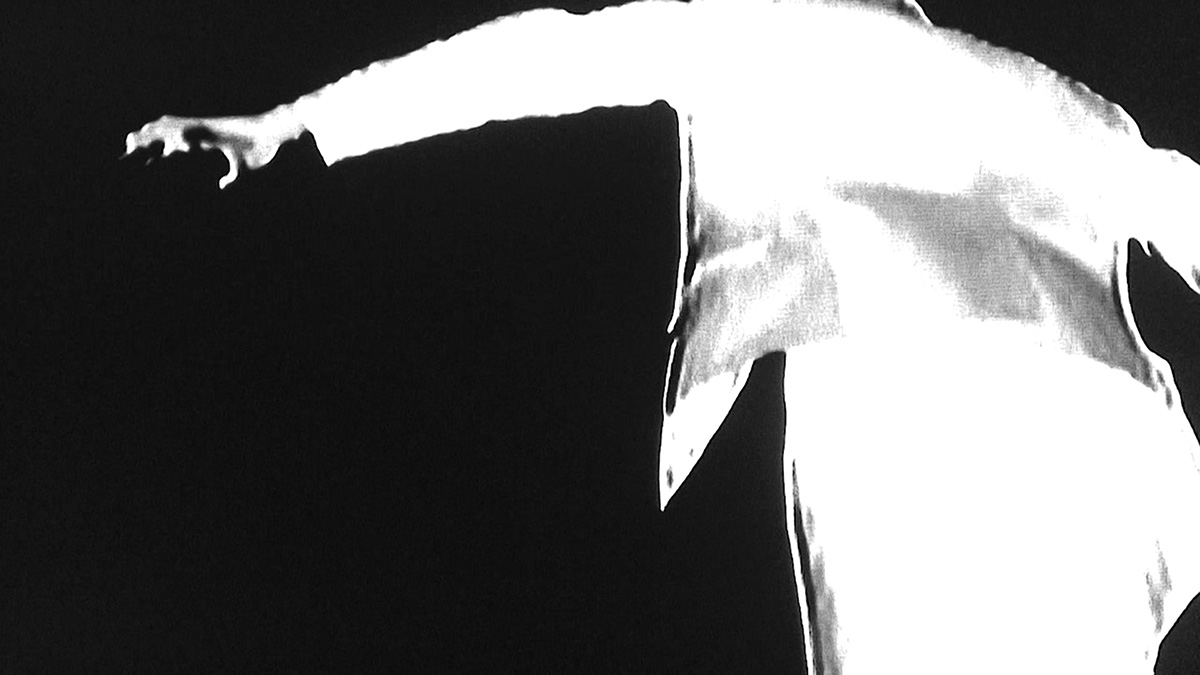

Dietmar Brehm
Hylo - Vision - Plus (Version 1)
Experimental video | 0 | color | 3:18 | Austria | 2023
Dietmar Brehm's Hylo-Vision-Plus. Version 1 is a minimalistic study of ecstatic moments and it is named after eye-drop medicine.
born in 1947 in Linz 1967-72 studied painting at the University of Fine Arts/Linz. Professor at the University of Fine Arts/Linz. Drawing + painting, experimental films and photography. Numerous filmscreenings and exhibitions at home and abroad. 1974-1989: 74 Super8 films since 1990: 16mm films since 2000: video

Dietmar Brehm
Inside - The Color Version
Video | hdv | color | 5:0 | Austria | 2017
It hisses, it blinks. A virtual, two-dimensional anaglyph flickers in red and green, unfolding a visual space true to the Brehmian aesthetic. Concentratedly condensed collisions occur between everyday life and the world, being and performing, symbols and icons. A human skull, human bodies, Castle Grafenegg as an architectonic stand-in for the uncanny … Sex and crime, art and pop culture flicker at pixilated speed – the stuff of dreams – most penetrating however brief. The mundane alternates with the fetish, glimpsed in the blink of an eye, intersected by a long drag on a Chesterfield cigarette while the full-bodied, tube-amped slow-motion reverb sound of a guitar swings in the background.
Dietmar BREHM Born in 1947 in Linz. 1967-72 studied painting at the Academy of Fine Arts/Linz professor at the Academy in Linz. Since 1973 teaches at the Academy in Linz. Drawing + painting, experimental films and photography. Numerous filmscreenings and exhibitions at home and abroad, various awards for his work.
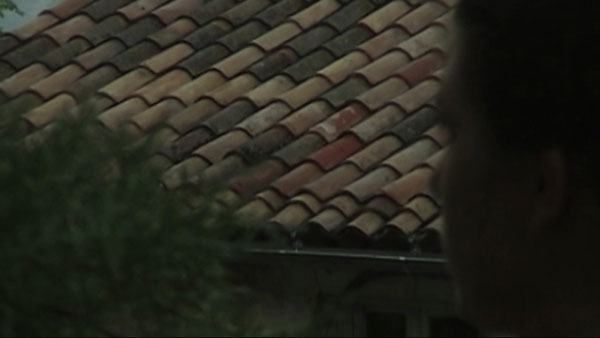
Andreas Brehmer
La Reprise. a description
Video | dv | color | 16:35 | Germany, France | 2010
/Users/andbrehm/Dropbox/Private/_Lebenslauf/140216_abrehmer_CV_ganz-kurz.txt

Michele Bressan
fifth,sixth and seventh floor
Documentary | dv | color | 4:27 | Romania | 2010
The block across the street, or mirror block, has been for the past 17 years my immediate landscape, a modular display of my closest reality, one I often avoided, as familiar images get skipped, distancing into the background. It happens because repetition eventually subsides the identification process. I chose to recognize the occurrences nearby and regard my quotidian landscapes as a view, put together by architecture and space boundaries, which also cause an involuntary voyeurism to appear.
Michele Bressan (b.1980) in the last few years his works were exhibited in several solo and group exhibitions, including Museum fur Photographie Braunschweig (2013), Centre Wallon d`Art Contemporain (2012), ViennaFair The New Contemporary (2012), Les Rencontres d`Arles photo festival (2011), Musée d`Art Moderne Saint Etienne (2011), Gate11 international departures, Fondazione Fotografia Modena (2011), Biennale di Venezia, Padiglione Italia nel Mondo (2011), Mois de la Photo (2010), National Museum of Contemporary Art Bucharest (2009/2010), Performance Art Institute San Francisco (2010), ESSL Museum Wien (2009), Neuen Museum/ Bauhaus Universitat Weimar (2009). In 2010 he won the Constantin Brabcusi fellowship at the Cité Internationale des Arts Paris. In 2009 he recived the ESSL award for photography, in the same year was nominee for the Henkel award.

Elsa Brès
Sweat
Experimental film | 0 | color | 29:29 | France | 2020
Les premières tentatives de cartographier le delta du Mississippi remontent au début du XVIIIe siècle. Milieu incontrôlable, fragile et mouvant en soi, il est depuis constamment transformé pour l'exploitation de ses ressources. Navigant entre les temps et les espaces, "Sweat" nous immerge progressivement entre les lignes des cartes, dans la part insubordonnée et fluctuante de ce territoire, en compagnie d'êtres vivants qui le peuplent.
Elsa Brès est diplômée du Fresnoy - Studio national des arts contemporains, Tourcoing (France), et de l'École Nationale Supérieure d'Architecture de Paris-Belleville (France), où elle a enseigné la théorie de l'architecture et du paysage. Ses films et installations s'attachent à des forces de résistance dans les paysages contemporains, et ont été montrés dans des festivals et expositions, en France et à l'étranger, notamment au FID Marseille (France); à 25FPS, Zagreb (Croatie); au CRAC – Centre régional d’art contemporain Occitanie, Sète (France); au Palais de Tokyo, Paris (France); à la Transmediale, Berlin (Allemagne). Elle vit à Bréau, dans les Cévennes (France).
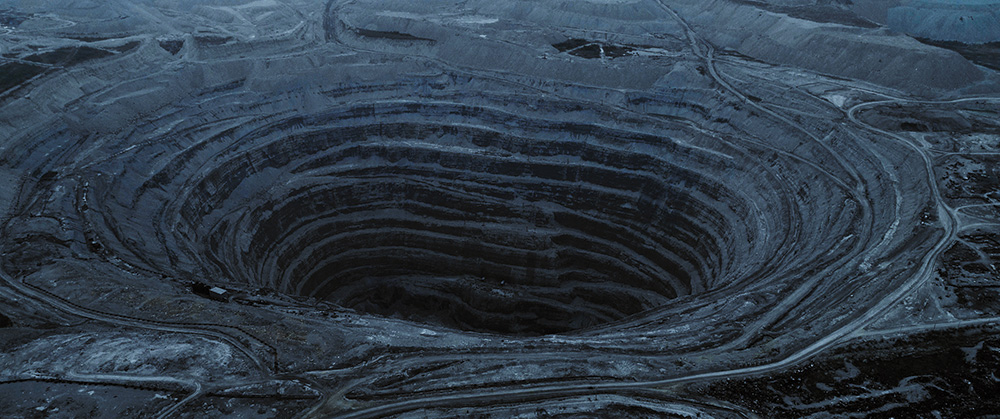
Viktor Brim
Dark Matter
Experimental doc. | 4k | color | 19:52 | Germany, Russia | 2019
A trace of regularly ordered mounds of earth. In the twilight a dump truck is being loaded. A thick veil of mist hangs over the tops of the trees. Dark earth is excavated, loaded and transported off the scenery. In Dark Matter (2020), via the situative arrangement of different picture elements a visual friction surface is created, which is shaped by the figurations of a post-apocalyptic landscape. The images are determined by the processes of extracting raw materials. Without the mineral resources from the numerous diamond and gold mines in the so-called Russian Federation subject Yakutia, the Soviet Union would never have been able to exist until the 1990s. Technology and ideology go hand in hand and leave their mark. Military and economic efforts to secure power are inscribed in this landscape. The extraction of raw materials and the exploitation of nature show their planned economic and geopolitical consequences, which make up the character of the “subjects of the Federation”. Their designation as “subjects” was introduced in the USSR in order to equip and administer different categories of territorial units with different degrees of autonomy. Technological progress and ideological utopias constitute a processual and changeful network of relationships between subject definition and state apparatus.
Viktor Brim was born in 1987 in Tashkent, Uzbekistan. From 2009 to 2011 he studied media art at the HGB in Leipzig, began directing studies at the Filmuniversity Babelsberg KONRAD WOLF and completed a postgraduate course at the Academy of Media Arts in Cologne, where he worked not only with fictional forms but also increasingly with documentary approaches.


Viktor Brim
beocming unreal
Experimental film | dcp | color | 17:35 | Germany | 2023
In Becoming Unreal the camera floats through urban mega-projects of Istanbul like modern mosques, the new airport and various hotel buildings. These spaces are marked by an emptiness, as they embody more of a trophy, a sculpture or an object and have no longer anything to do with the human body. A ghostly absence characterizes the buildings. They are like an immaculate representative facade, one of concealment and hiding. A facade made up of complicated shell companies and offshore providers.
Viktor Brim (born 1987 in Tashkent, Uzbekistan) is an artist and filmmaker. In his work he deals with the relationship between cinematic spaces, urban phenomena and the concept of power. His focus is on the physical manifestation of power structures and their territorial extension. Most recently, his works have been presented at Casino Luxembourg - Forum d'art contemporain, Eye Filmmuseum and Max Ernst Museum Brühl.
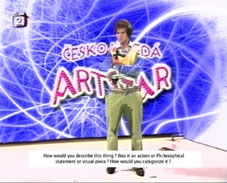

Ondrej Brody, Kristofer PAETAU
Artstar
Experimental video | dv | color and b&w | 3:0 | Czech Republic | 2006
Neo-Dadaistic artist duo that hunts for grotesque aspects of both the institutionalized art world and the very phenomena of art production itself. Their strategy is obvious and almost embarrassing in its literacy and straightforwardness but apparently that is their strongest aspect. Their issues and targets are elemental as well: everyday ethics, not to say moral code booklets, become their source of subject-matter-like vocabulary. The investigation is always and first of all in regards to the psychology of behavior as influenced or provoked by the external aspects of life and politics. Oscillating between use and abuse, advanced manipulation and cold untouchable registration of absurd reality, their work is truly critical and sincere in its desire to uncover the pathologies and hidden normalcies of inter-human relations. Their actions are always well structured and the dramaturgy is almost perfect, precise, and calculated, cold and emotionally disturbing, bold and vicious - thoroughly penetrating. It perhaps only needs to be more carefully balanced: the desired scandal properly used as a tool to emphasize a decay of certain values and their sudden corruption.
Ondrej Brody was born in Prague, Czech Republic in 1980, and currently lives between Antwerp, Berlin, and Prague. In his early childhood he lived in Guayaquil, Ecuador, where he remained until 1999. In 2000 he started his art degree at the Instituto Superior de Arte in Havana, Cuba. In 2001, he transferred to the Academy of Fine Arts in Prague, where he received his degree in 2005. He is a visual artist who works mainly with video and interventions/actions. His recent exhibitions include: Jiri Svestka Gallery, Prague (2006); Kunsthallen Brandts, Odense, (2006)' Sammlung Essl, Klosterneuburg/Vienna, (2005); and Jack the Pelican, New York City, (2006), among others. His prizes include the Essl Award, Sammlung Essl, Vienna, Austria (2205), and the International Prize for Performance, Galeria Civica, Trento, Italia (2006). Kristofer Paetau was born in Borga, Finland in 1972. He spent years studying various disciplines. In 2005/06 he was at the Higher Institute for Fine Arts (HISK), Antwerp, Belgium; in 2000/01 he did a Post-Diplome International ERBAN, Nantes, France; in 1999/2000 he received a Meisterschüler Diploma, having studied in the class of John M. Armleder at the Hochschule für Bildende Künste (HBK), Braunschweig, Germany; in 1999 he earned a MA in Art studies at the Ecole Nationale Supérieure d'Arts, Cergy, France; in 1993/94 he studied Art history at the Ecole du Louvre, Paris, France; and in 1991/92 he studied aesthetics and French at the University of Helsinki, Finland. His artistic experience includes various types of projects and work, such as: in 2004 - curated project "St. Stephanus Church", with Torsten Prothmann, Berlin, Re-Institutionalize #03, and solo show: "Antigraffitihiphop" installation and dance performance, at Paul Ekaitz 5050 Gallery, Berlin; in 2005 - group show "BoundLess", participation in the work of Jan Christensen, Stenersenmuseet, Oslo, Norway (catalogue), and performance: "Belgian Air Guitar Champion", In/Out Space, Open Studios, Higher Institute for Fine Arts, Antwerp, Belgium, and in 2006 - project "Super-Flux" e-mail service, together with Ondrej Brody. A short-time concurrence to e-Flux, and "Picturepeople", an e-mail-project (work in process), together with Rüdiger Heinze the writer.

Persijn Broersen, Margit Lukacs
Forest on Location
Video | hdv | color | 11:42 | Netherlands | 2018
Broersen and Lukacs construct a replica of Bialowieza primeval forest. In this virtual forest is the avatar of Iranian operasinger Shahram Yazdani, who performs his version of Nat King Cole's 1948 hitsong Nature Boy, whose melody originated in Bialowieza. In Forest on Location, nature is viewed as a mirror, reflecting our own perception.
Margit Lukács and Persijn Broersen are artists based in Amsterdam, working together since 2002. In today’s visual culture, fiction is usurping the place of reality. Broersen & Lukács respond to this by creating video animations presenting a parallel world of spectacular images that wholly absorb the viewer in which 'nature' functions as a mirror for our media-dictated culture. Their works, consisting of layered projections, digital animations and spatial installations, have been exhibited for instance at the Biennale of Sydney (Australia), Rencontres internationales de la photographie d'Arles (France), Wuzhen Biennial Now Is The Time (China), Stedelijk Museum Amsterdam (Netherlands), FOAM Amsterdam (Netherlands), Antwerp contemporary art museum MUHKA (Belgium), Centre Pompidou (France), Shanghai World Expo (China), Kröller Müller (Netherlands)) and Casa Enscendida (Spain). Their films have been shown at various festivals including Oberhausen International Film Festival (Germany), LAForum (US), Kassel Dokumentar und Filmfestival (Germany), Rencontres Internationales Paris/Berlin (France/Germany), the New York International Film Festival (US), and Rotterdam International Film Festival and Amsterdam International Documentary Film Festival. Their film "Establishing Eden" was included in the 2016 Tiger Awards Competition for Short Films in Rotterdam Festival. In 2015, Stedelijk Museum Amsterdam acquired the site-specific work "Ruins in Reverse" (2015), specially made for the museum. Broersen & Lukács are represented by Galerie AKINCI, Amsterdam.


Broersen & Lukacs
Prime Time Paradise
Art vidéo | dv | color | 11:0 | Netherlands | 2004
Every day, news reports and other TV images pass by in an endless stream that numbs the viewer, who, as if hypnotized, does nothing more than watch and watch: constantly zapping to the next image or channel, in a steady flow; there is no more standing still. Attention is fragmentary; identification and reflection are impossible, there is always something happening, and old and new images crop up time and again in different places: behind a mountain a town is burning; a soldier is aiming his gun; a girl is screaming; and a (destroyed) beach lies next to the building where a UN top meeting is taking place.
Margit Lukács was born in Amsterdam, Holland, in 1973, and Persijn Broersen was born in Delft, Holland, in 1974. They currently live and work in Amsterdam. They both studied Graphic Design at the Gerrit Rietveld Academy in Amsterdam from 1994-1998, and completed Masters Degrees in Design and Fine Arts at the Sandberg Institute in Amsterdam from 1998-2001. Their work has been exhibited throughout the Netherlands and in various other countries including China, India, and Japan, and they participated in the International Artists Studio Program in Stockholm, Sweden, in 2005. Broersen and Lukács create videos that employ footage in a number of ways, including scenes they have filmed themselves, images appropriated from television news reports, and digitally animated segments to create flowing, smoothly edited montages. Some of their pieces are highly narrative and seem almost autobiographical, while others specifically resist presenting a coherent narrative in order to critique how the media makes it impossible for viewers to critically reflect on the images they present. Utopic and dystopic fantasy landscapes operate in a number of ways in Broersen and Lukács's work, showing how various narratives presented by the mass media and general culture come to constitute whole worlds for the people who absorb them.


Broersen & Lukács, Margit Lukacs
Beyond Sunset & Sunrise
Experimental fiction | hdv | color | 28:30 | Netherlands, USA | 2013
The copy-paste mentality of the media and its audience is reflected in the film Beyond Sunset & Sunrise; a mosaic-film in which Broersen & Lukács connect scripts and characters from classic Hollywood movies such as ?Sunset Boulevard?, ?Badlands?, ?Wild at Heart?, ?The Last Picture Show? and ?All About Eve?, a range of films in which the protagonists struggle with their aspirations. Aspirations that eventually turn destructive. Shot entirely in Hollywood, this fictional network of a dream chasing community merges with the reality facing the ambitious actors; a no-man?s land between Los Angeles and Hollywood. A place where dreams define reality, and the dream is defined by reality.
Margit Lukács (Amsterdam, 1973) & Persijn Broersen (Delft, 1974) are artists living and working in Amsterdam and Paris. They work in a wide variety of media- most notably video, animation and graphics- producing a myriad of works that reflect on the ornamental features of today`s society. The work of Broersen & Lukács is characterized by a quest for the sources of contemporary visual culture. With intricate layers of depersonalization, re-mediation and re-interpretation they demonstrate how reality, (mass) media and fiction are strongly intertwined in contemporary society. Broersen & Lukács studied at the Sandberg Institute and at the Rijksakademie in Amsterdam. Their films, installations and graphic work have been shown internationally, including: Centre Pompidou Paris (FR), MUHKA Gent (BE), Coca in Torun (PL), Kunsthalle Tallinn (EST) and the Stedelijk Museum Amsterdam. Their films have been shown at film festivals worldwide including LAForum in Los Angeles (USA), Experimenta Media Arts Biennale (AUS), Kassel Dokumentar Film Festival (DE), Paris Rencontres (FR, ESP, DE), International Film Festival Rotterdam and the IDFA in Amsterdam (NL). Broersen & Lukács have been invited to participate in the 19th Sydney Biennale, 2014.